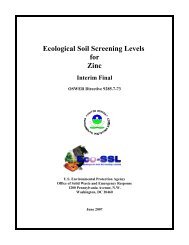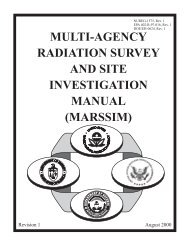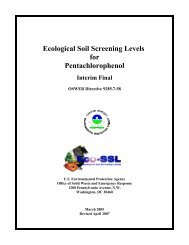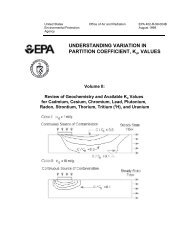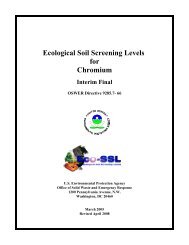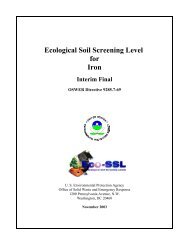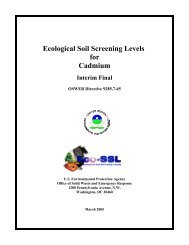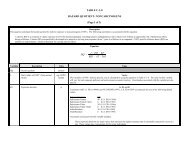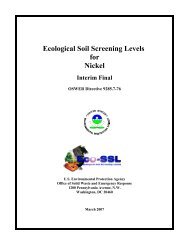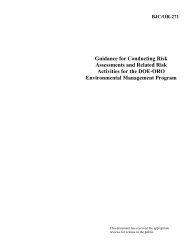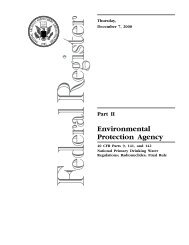Selenium - The Risk Assessment Information System
Selenium - The Risk Assessment Information System
Selenium - The Risk Assessment Information System
Create successful ePaper yourself
Turn your PDF publications into a flip-book with our unique Google optimized e-Paper software.
2.0 SUMMARY OF ECO-SSLs FOR SELENIUM<br />
<strong>Selenium</strong> is a naturally occurring element found in all environmental media: air, soil, sediment,<br />
and water. In nature it is found in the sulfide ores of heavy metals and predominates in<br />
approximately 40 minerals including clausthalite, naumannite, tiemannite, and berzelianite<br />
(Budavari, 1996; Fishbein, 1991). <strong>Selenium</strong> is also found in volcanic rock, sandstone, shale,<br />
carbonates, bedrock, coal oil, and mineral oil (Kent and Spycher, 1994; Langer, 1993).<br />
<strong>Selenium</strong> may be released to the environment from natural sources such as volcanic eruptions,<br />
leaching and weathering of rocks, and volatilization as a result of biomethylation by plants and<br />
bacteria (ATSDR, 1996). Anthropogenic releases of selenium may result from use in the<br />
manufacture and production of glass, pigments, rubber, metal alloys, textiles, petroleum, medical<br />
therapeutic agents, anti-dandruff shampoos, veterinary medicines, fungicides, gaseous insulators,<br />
and photographic emulsions (USDOI, 1985; ATSDR, 1996). <strong>The</strong> burning of coal, oil and solid<br />
waste may also contribute to selenium in the environment (NRC, 1976; ATSDR, 1996).<br />
Background concentrations<br />
reported for many metals in U.S.<br />
soils are described in Attachment<br />
1-4 of the Eco-SSL guidance<br />
(U.S. EPA, 2003). Typical<br />
background concentrations of<br />
selenium in U.S. soils are plotted<br />
in Figure 2-1 for both eastern and<br />
western U.S. soils.<br />
In soils, the chemical forms of<br />
selenium are largely dependent<br />
on pH and oxidation-reduction<br />
potentials (McNeal and<br />
Balistrieri, 1989). <strong>Selenium</strong> can<br />
exist in the 2-, 0, 4+, and 6+<br />
oxidation states (McNeal and<br />
Balistrieri, 1989). Speciation of<br />
selenium in soils is also<br />
Conc (mg/kg dw)<br />
influenced by the chemical and mineralogical composition of the soil,<br />
microbial intervention, and the nature of the adsorbing surfaces (Neal,<br />
1990). <strong>Selenium</strong> has a sorptive affinity for hydrous metal oxides, clays,<br />
and organic materials. In well-aerated alkaline soils, inorganic selenium<br />
exists primarily as the oxyanions selenite (Se(4+)) and selenate (Se(6+)).<br />
4<br />
3.5<br />
3<br />
2.5<br />
2<br />
1.5<br />
1<br />
0.5<br />
0<br />
East West<br />
Figure 2-1 Typical Background<br />
Concentrations of <strong>Selenium</strong><br />
in U.S. Soils<br />
Maximum<br />
Eco-SSL for <strong>Selenium</strong> 2<br />
July 2007<br />
95th<br />
75th<br />
50th<br />
25th<br />
5th Percentile<br />
Selenite is soluble, but can strongly adsorb to soil minerals and organic material (Tokunaga et al.,<br />
1997), while selenate is the most mobile of selenium compounds because of its high water<br />
solubility and inability to adsorb to soil particles (ATSDR 1996). Alkaline soils formed from<br />
parent materials high in selenium are also high in biologically available selenium (Mayland et al.,<br />
1989). In poorly aerated soils, inorganic Se predominates as the relatively soluble selenide and



